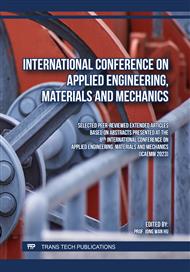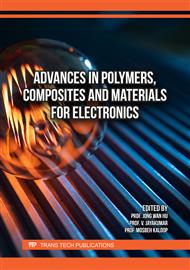[1]
S. Karimifard, M.R. Alavi Moghaddam, Application of response surface methodology in physicochemical removal of dyes from wastewater: A critical review, Sci. Total Environ., 640-641 (2018) 772-797.
DOI: 10.1016/j.scitotenv.2018.05.355
Google Scholar
[2]
N.P. Raval, P.U. Shah, N.K. Shah, Adsorptive amputation of hazardous azo dye Congo red from wastewater: a critical review, Environ Sci Pollut Res Int, 23 (2016) 14810-14853.
DOI: 10.1007/s11356-016-6970-0
Google Scholar
[3]
E. Hosseini Koupaie, M.R. Alavi Moghaddam, S.H. Hashemi, Evaluation of integrated anaerobic/aerobic fixed-bed sequencing batch biofilm reactor for decolorization and biodegradation of azo dye acid red 18: comparison of using two types of packing media, Bioresour. Technol., 127 (2013) 415-421.
DOI: 10.1016/j.biortech.2012.10.003
Google Scholar
[4]
S.A. Ishak, M.F. Murshed, H. Md Akil, N. Ismail, S.Z. Md Rasib, A.A.S. Al-Gheethi, The Application of Modified Natural Polymers in Toxicant Dye Compounds Wastewater: A Review, Water, 12 (2020).
DOI: 10.3390/w12072032
Google Scholar
[5]
I. Ali, New generation adsorbents for water treatment, Chem. Rev., 112 (2012) 5073-5091.
DOI: 10.1021/cr300133d
Google Scholar
[6]
E.C.R. Lopez, V.A.F. Cleofe, R.Y.A. Cañal, K.F.P. Boado, J.V.D. Perez, Highly-Organized One-Dimensional Copper-Doped Titanium Dioxide Nanotubes for Photoelectrocatalytic Degradation of Acid Orange 52, Key Eng. Mater., 801 (2019) 285-291.
DOI: 10.4028/www.scientific.net/kem.801.285
Google Scholar
[7]
E.C.R. Lopez, N.E.B. Saputil, L.A. Loza, F.F.G. Camiguing, M.J.L. Mopon, J.V.D. Perez, Iron/Sulfur Co-Doped Titanium Dioxide Nanotubes: Optimization of the Photoelectrocatalytic Degradation of Phenol Red under Visible Light, Key Eng. Mater., 847 (2020) 95-101.
DOI: 10.4028/www.scientific.net/kem.847.95
Google Scholar
[8]
E.C.R. Lopez, J.D. Ocon, J.V.D. Perez, Synthesis of Silver-Doped Titanium Dioxide Nanotubes by Single-Step Anodization for Enhanced Photodegradation of Acid Orange 52, Mater. Sci. Forum, 950 (2019) 149-153.
DOI: 10.4028/www.scientific.net/msf.950.149
Google Scholar
[9]
G. Crini, E. Lichtfouse, L.D. Wilson, N. Morin-Crini, Conventional and non-conventional adsorbents for wastewater treatment, Environmental Chemistry Letters, 17 (2018) 195-213.
DOI: 10.1007/s10311-018-0786-8
Google Scholar
[10]
M. Ateia, D.E. Helbling, W.R. Dichtel, Best Practices for Evaluating New Materials as Adsorbents for Water Treatment, ACS Materials Letters, 2 (2020) 1532-1544.
DOI: 10.1021/acsmaterialslett.0c00414
Google Scholar
[11]
S. Rojas, P. Horcajada, Metal-Organic Frameworks for the Removal of Emerging Organic Contaminants in Water, Chem. Rev., 120 (2020) 8378-8415.
DOI: 10.1021/acs.chemrev.9b00797
Google Scholar
[12]
S. Rojas, P. Horcajada, Metal-Organic Frameworks for the Removal of Emerging Organic Contaminants in Water, Chem. Rev., 120 (2020) 8378-8415.
DOI: 10.1021/acs.chemrev.9b00797
Google Scholar
[13]
W. Li, J. Cao, W. Xiong, Z. Yang, S. Sun, M. Jia, Z. Xu, In-situ growing of metal-organic frameworks on three-dimensional iron network as an efficient adsorbent for antibiotics removal, Chem. Eng. J., 392 (2020) 124844.
DOI: 10.1016/j.cej.2020.124844
Google Scholar
[14]
Y. Gong, B. Yang, H. Zhang, X. Zhao, A g-C3N4/MIL-101(Fe) heterostructure composite for highly efficient BPA degradation with persulfate under visible light irradiation, Journal of Materials Chemistry A, 6 (2018) 23703-23711.
DOI: 10.1039/c8ta07915c
Google Scholar
[15]
Lu, Yang & Liu, Chaozheng & Mei, Changtong & Sun, Jinsheng & Lee, Juhyeon & Wu, Qinglin & Hubbe, Martin & Li, Mei-Chun. (2022). Recent advances in metal organic framework and cellulose nanomaterial composites. Coordination Chemistry Reviews. 461. 214496.
DOI: 10.1016/j.ccr.2022.214496
Google Scholar
[16]
Liu, Z., He, W., Zhang, Q., Shapour, H., & Bakhtari, M. F. (2021). Preparation of a GO/MIL-101(Fe) Composite for the Removal of Methyl Orange from Aqueous Solution. ACS Omega, 6(7), 4597–4608
DOI: 10.1021/acsomega.0c05091
Google Scholar
[17]
Uma, K., Pan, G. T., & Yang, T. C. K. (2017). The preparation of porous sol-gel silica with metal organic framework MIL-101(Cr) by microwave-assisted hydrothermal method for adsorption chillers. Materials, 10(6)
DOI: 10.3390/ma10060610
Google Scholar
[18]
Perez, J. V. D., Nadres, E. T., Nguyen, H. N., Dalida, M. L. P., & Rodrigues, D. F. (2017). Response surface methodology as a powerful tool to optimize the synthesis of polymer-based graphene oxide nanocomposites for simultaneous removal of cationic and anionic heavy metal contaminants. RSC Advances, 7(30), 18480–18490
DOI: 10.1039/c7ra00750g
Google Scholar
[19]
Hendrawan, H., Khoerunnisa, F., Sonjaya, Y., & Putri, A. D. (2019). Poly (vinyl alcohol)/glutaraldehyde/Premna oblongifolia merr extract hydrogel for controlled-release and water absorption application. IOP Conference Series: Materials Science and Engineering, 509, 012048
DOI: 10.1088/1757-899x/509/1/012048
Google Scholar



